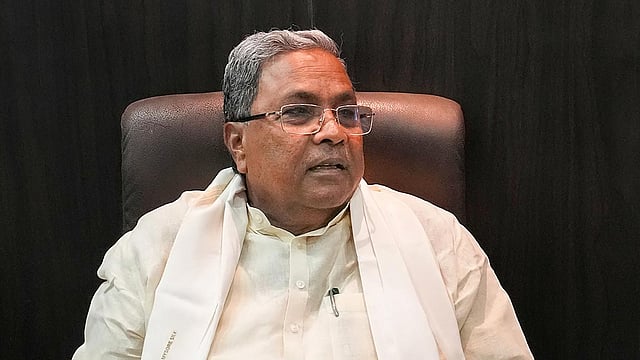Leader of Opposition R Ashoka alleged that the report confirmed the “financial decline” of Siddaramaiah-led Karnataka.
Published Aug 21, 2025 | 2:56 PM ⚊ Updated Aug 21, 2025 | 2:56 PM

Karnataka CM Siddaramaiah. (X)
Synopsis: The largest subsidy component was power subsidy which included Gruha Jyoti and subsidy provided for supply of free electricity to farmers for usage of agricultural pump sets.
The five pre-poll guarantee schemes implemented by the Congress government in Karnataka have dented the state’s coffers. To fund the schemes and deficits arising due to it, the state borrowed Rs 63,000 crore which was Rs 37,000 crore more than the last year’s net borrowings, according to a detailed report from the Comptroller and Auditor General (CAG).
The report, which was presented in the Assembly on Tuesday, 19 August, detailed the state’s finances for the year 2023-24. The five pre-poll guarantees — Gruha Lakshmi, Gruha Jyoti, Anna Bhagya, Shakti and Yuva Nidhi – contributed to the state’s revenue deficit of Rs 9,271 crore. Consequently, the fiscal deficit of the state also increased from Rs 46,623 crore in 2022-23 to Rs 65,522 crore in 2023-24.
While the five guarantee schemes boosted the local economy, reduced economic disparities and supported human capital development, the finance department noted in the CAG report that without rationalisation of existing subsidies, the schemes would strain the financial economy of the state.
The state had earlier made a budget provision of Rs 36,538 crore for the five schemes for the 2023-24 financial year, with almost the entire amount utilised. However, the implementation of these schemes resulted in the increase in growth of the state’s expenditure (12.54 percent from the previous year).
This is the scheme-wise spending in 2023-24 (in crores):
Gruha Lakshmi: Rs 16,964.40
Gruha Jyothi: Rs 8,900
Anna Bhagya: Rs 7,344.68
Shakti: Rs 3,200
Yuva Nidhi: Rs 88.88
The CAG report noted that while the state’s revenue grew by 1.86 percent over last year, there was a mismatch of receipt and expenditure during the current year. This resulted in the state witnessing a revenue deficit of Rs 9,271 crore after its recovery during 2022-23 from Covid-induced economic slowdown, the report said.
With regards to the state’s net market borrowing of Rs 63,000 crore being higher than last year’s figures, the CAG said it would not only increase repayment burden in the near future but would also enormously increase the interest burden of the state.
Under revenue expenditure, committed expenses make up the largest portion. These are the costs the government must pay first and include interest payments, salaries, wages, and pensions. Even though the Fiscal Management Review Committee (FMRC) in 2023 urged the state to reduce its committed expenditure, the CAG report noted that there would be an increase in committed expenditure on account of the increase in interest payment due to raise in internal debt of the state.
Between 2019-20 and 2023-24, these committed expenses made up 40 to 44 percent of the total revenue expenditure. They rose from Rs 94,326 crore in 2022-23 to Rs 1,02,637 crore in 2023-24, a nine percent increase.
Apart from this, “inflexible expenditure” dropped as a share of revenue expenditure from 34.96 percent to 31.66 percent between 2019-20 and 2023-24. However, the actual amount still went up slightly, from Rs 75,325 crore in 2022-23 to Rs 76,808 crore in 2023-24, a 1.97 percent rise. On average, inflexible spending grew by 7.21 percent annually from 2019-20 to 2023-24.
In total, committed and inflexible expenses together amounted to Rs 1,79,445 crore in 2023-24 — about 74 percent of revenue expenditure. This leaves the government with limited room to spend on other important areas like development and infrastructure, the report said.
The state also had to reduce the capital expenditure towards infrastructure by around Rs 5,229 crore when compared to previous year. The number of incomplete projects rose to 3,140 from 1,864, and the funds aggregating to Rs 4,482 crore were locked up in the incomplete projects.
“This has an impact on the increase in incomplete projects by 68 percent when compared to previous year. This compression in gross capital formation may prove to be detrimental to future growth prospects,” the report added.
The CAG also noted that three of the guarantee schemes — Gruha Jyoti, Anna Bhagya, and Shakti — were in the form of subsidies. As a result, the state’s subsidy burden got pushed up to Rs 60,774 crore.
The largest subsidy component was power subsidy which included Gruha Jyoti and subsidy provided for supply of free electricity to farmers for usage of agricultural pump sets. It constituted a major portion of around 57 percent of the total subsidies, the report said.
Meanwhile, the report also outlined some worrying long-term projections. Under the Medium-Term Fiscal Plan for 2024-28, Karnataka expects a revenue deficit of Rs 27,354 crore, with overall borrowings likely to rise to Rs 1.05 lakh crore.
The CAG report triggered a political storm with Opposition leaders from BJP slamming the Congress government for “over-spending”.
“This shows a financial mismanagement by the Karnataka government and a significant deficit. The government is struggling to pay salaries on time, with three to four months of pending wages for contract labourers across various departments, pushing the state towards bankruptcy. The government should release a white paper to transparently address these issues,” BJP MLA Bharath Shetty Y told reporters on Wednesday.
Leader of Opposition R Ashoka alleged that the report confirmed the “financial decline” of Siddaramaiah-led Karnataka.
“The Karnataka government, for short-term political gains, is sacrificing the future of Karnataka. If this system continues, Karnataka will be trapped in irrecoverable debt and economic bankruptcy, with guaranteed stagnation in development,” he said.
(Edited by Amit Vasudev)
